* (rerun)

from Intense Vocalization: Marguerite Duras
by David Ehrenstein
‘ The Marguerite Duras retrospective at the Film Society of Lincoln Center this month—18 years after the celebrated auteur’s death—presents an ideal opportunity to contemplate her place in the history of cinema. For while Hiroshima Mon Amour, the screenplay she wrote for Alain Resnais to direct, became an international success in 1960 (and remains a touchstone of “art cinema” to this day), the films she subsequently created on her own, beginning in 1969 with Destroy, She Said, have been alas, for the happy few. …
‘Destroy, She Said unfolds in the garden of a country hotel adjoining a forest that threatens the soigné guests (Michael Lonsdale, Henri Garcin, Nicole Hiss, Catherine Sellers) in some strange, difficult-to-define way comparable to to the “something” that so unsettles the upper-crust swells in Edward Albee’s A Delicate Balance. Low-key in tone, it does not seem like the sort of “art film” designed to break new ground. But it does so, and by explicit intention: Duras described her text as “a book that could either be read or acted or filmed or, I always add, simply thrown away.” The key word in this is “book,” as literature is always primary for Duras—even in the midst of the seemingly resolutely “cinematic.” It’s not by accident that Lonsdale—soon to emerge as a key Duras interpreter—plays a character called “Stein.” His name is derived from Duras’s novel The Ravishing of Lol V. Stein, the most crucial work of her entire oeuvre. …
‘Duras had no hope of replacing “real movies” with her conditionally tensed ones, but she went on making her sui generis works anyway—aided by a curious “real-life” character named Yann Andrea. A fan of India Song, Andrea entered Duras’s world in 1980 when he helped her through a “rest cure” designed to stem her alcoholism. His account of this, in a 1983 book entitled M.D., was met with some degree of critical interest. Duras’s own interest in Andrea quickly became an obsession. He appears with Bulle Ogier in Agatha et les lectures illimitées her 1981 reworking of elements that first appeared in her early biographical novel Un barrage contre le Pacifique (aka The Sea Wall), filmed by René Clément as This Angry Age in 1957. While Anthony Perkins and Sylvana Mangano play characters based on Duras and her brother in Clement’s version, their emotional conflict doesn’t go so far as incest, which is frankly discussed in Agatha. As nothing in the film is conventionally dramatized (Andrea and Ogier are seen wandering about the lobby of a hotel on the Normandy coast that also served as a setting for her India Song variation avant la lettre, La Femme du Gange, in 1974), no acting in the conventional sense was required. …
‘Curiously, Duras ended her filmmaking career with something resembling the conventional. Les Enfants began life as a 1970 book she wrote for children entitled Ah! Ernesto, later filmed by Jean-Marie Straub and Danièle Huillet in 1982 as En rachâchant (a rendition Duras disliked; also part of the retrospective’s shorts program). The story concerns a little boy who doesn’t want to go to school lest he learn things that he doesn’t already know. Les Enfants expands this slim tale to feature length with the novelty of having Ernesto played by an adult actor, Axel Bogousslavsky. It’s wryly amusing in a way quite unusual for Duras. More importantly, it’s shot in a more or less ordinary style, with actors playing actual characters and speaking words on screen in the usual manner.
‘That Duras would conclude her filmmaking career in this manner must be regarded in the context of a career that was devoted to textual elucidation. One suspects that the success of her novel The Lover in 1984—an overwhelming hit with both critics and the general public—put her off from filmmaking. Jean-Jacques Annaud’s 1992 adaptation of this tale, which was another derivation from the Un barrage contre le Pacifique cycle and which related how her family pimped her out to a wealthy Chinese man, was served up in the plush “high-class” erotic style of the Emmanuelle films. In what you might call anticipatory retaliation, Duras in 1991 wrote The North China Lover, a “remake” of The Lover adding details that the first version of Duras’s original novel didn’t include, all folded into an explicit critique of the film she suspected (with good reason) Annaud was putting together.’
____
Stills

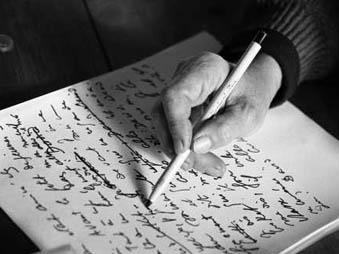


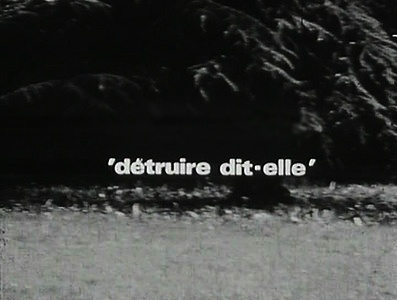






















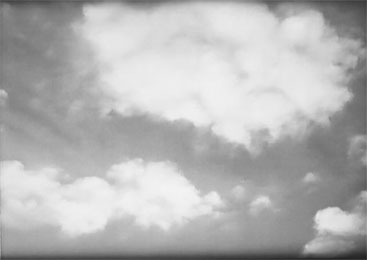














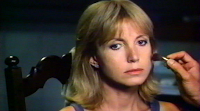

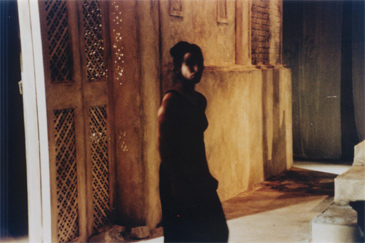










____
Further
Marguerite Duras @ IMDb
Association Marguerite Duras
Société Internationale Marguerite Duras
Les Écrits de Marguerite Duras
‘La petite cuisine de Marguerite’
‘In Love with Duras’ by Edmund White
‘The obsessions of Marguerite Duras’
‘The Art of Fugue: on Marguerite Duras’s Film Aesthetics’
Interview avec Marguerite Duras
‘Yann Andréa, la dernière énigme de Marguerite Duras’
‘Initiales M.D. (Marguerite Duras) (+ DVD)’
‘Marguerite Duras, l’éternel retour’
Lettre de Marguerite Duras à Alain Resnais
Film: ‘Marguerite, A Reflection of Herself’
‘NOUVEAU ROMAN CINEMA: MARGUERITE DURAS’
‘The Film Society to Fete Marguerite Duras with October Retrospective’
____
Extras
Worn Out With Desire To Write (1985)
Marguerite Duras – “Écrire” (ARTE)
MARGUERITE DURAS À PROPOS DE L’AN 2000
Jean Luc Godard – Marguerite Duras
_______
L’interview imaginaire
from Versatile Mag
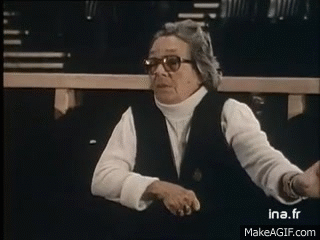
En 1996, vous décidez de tout arrêter, de ne plus écrire une ligne. Avez-vous l’impression d’avoir fait le tour de la question, de ne plus rien avoir à raconter ?
Marguerite Duras : Des fois, on se laisse prendre au jeu. Juste avant 1996, j’avais écrit un livre qui s’appelait C’est tout. Voilà, il y a des événements dans la vie, un peu comme la passion à laquelle on ne peut pas échapper et j’aurais pu continuer à écrire, j’aurais pu continuer à faire des reprises, à faire des modulations de mes œuvres, à l’infini.
Peu de voix se sont élevées concernant vos écrits, regrettez-vous cette absence de polémique ?
M. D. : Foutaises ! Conneries ! J’ai passé ma vie à être l’objet de polémiques. J’ai toujours divisé ce qu’ils appellent « le monde littéraire », j’ai soi-disant eu trop de casquettes alors que la seule qui me convient, c’est celle d’écrivain. Écrivain, mais pas de littérature. Écrivain.
En 2014… 2014, la Pléiade… Et sinon, on m’a toujours taxée de charabia complaisant, toujours jugé un vocabulaire limité, qu’on ne comprenait pas pourquoi Gallimard permettait qu’on sorte un de mes livres en y laissant autant de fautes de grammaire !
Et mon passage dans le journalisme, pour Libération, ça, ça a fait polémique. Sur l’affaire du Petit Grégory, par exemple. Donc, des polémiques : tout le temps.
Ces critiques concernent surtout vos adaptations sur scène, au cinéma qui, en revanche se sont vues mises à mal…
M. D. : Alors, il y a deux choses. Il y a les films que j’ai fait moi. Que j’ai écrits et réalisés moi. Ça, ce sont des films que l’on pourrait qualifier maintenant de films d’art et d’essai. C’est ma manière à moi de parler de l’écriture cinématographique, de dire qu’elle n’était pas forcément narrative, qu’on pouvait faire du cinéma autrement. Après, j’ai quand même collaboré avec le cinéma et ça s’est très bien passé : Hiroshima mon amour d’Alain Resnais, c’est un « classique », tout de même. Après, il y a eu certaines adaptation dont on est tous au courant , comme l’Amant qui a été adapté par Jean-Jacques Annaud. On n’était pas d’accord, mais il avait obtenu les droits… Mais ça m’a permis de faire un livre, et un bon livre, de reprendre après quelques années l’Amant et de sortir un livre qui s’appelle l’Amant de la Chine du nord. Un livre où j’ai écrit mon film, c’est-à-dire que l’Amant de la Chine du nord, c’est le film écrit de l’Amant… qui a eu beaucoup plus de succès que l’amant, son film.
L’essentiel de vos récits sont extraits de votre vie, au temps de la gloire du colonialisme français. Est-ce une sorte de nostalgie ?
M. D. : Pas du tout une nostalgie, c’est un décor. Il y a eu le décor de l’Indochine, de ce qu’on a appelé le cycle indochinois, mais après, il y eu d’autres décors, d’autres cycles dans mon œuvre. Il n’y a aucune question de nostalgie. J’y explique plutôt les tares du colonialisme. Et sinon les thèmes de mon œuvre, les thèmes que soi-disant, je reprends, je module et j’étire, le rapport à la mère, la mère qui forcément est toute puissante, mais qui forcément n’est pas à la hauteur. Et puis il y a la rencontre amoureuse, les femmes, des déclinaisons de femmes. Je parle aussi beaucoup dans mes livres des saisons uniques et humides et chaudes. Je parle de transgression sociale. Je parle souvent de colonialisme, mais pas le colonialisme clinquant : je parle souvent de Blancs, les petits Blancs moyens et comment ils se situaient, eux, dans le colonialisme.
Mais je parle aussi beaucoup de la Shoah.
Contrairement à vos écrits résolument tournés vers la passé, vous semblez apprécier la jeunesse, du moins dans le choix de vos compagnons, est-ce une manière de se tourner vers l’avenir ?
M. D. : L’avenir, je n’en ai rien à foutre. Enfin, c’est facile de dire cela quand on est édité dans la Pléiade, mais je suis plutôt – et c’est pour ça que vous me parlez de l’âge de mes compagnons – quelqu’un qui est dans le présent. Ce n’est pas du tout une question d’avenir, c’est une question d’être dans le présent et d’absorber tout ce que peut contenir le présent.
Que cherchez-vous à oublier ?
M. D. : J’écris, donc forcément quand on écrit, on n’oublie pas, on convoque. C’est prétentieux de dire qu’on est seul devant sa feuille. Moi, je convoque et à la limite, on peut dire que je retranscrits ce que j’ai convoqué, donc je n’essaie pas d’oublier : je bois plutôt pour faire face à tous ceux que je convoque, tous ceux que je ne peux pas oublier.
Selon vous, qui pourrait reprendre votre flambeau ?
M. D. : Grand silence
Un flambeau pour éclairer quoi ?
Beaucoup de gens se disent mes héritiers, mais je pense qu’il y a plein de gens qui croient écrire, qui croient écrire des livres, alors qu’ils n’écrivent rien.
Il faut écrire comme une nécessité absolue, dans l’urgence : oui, pourquoi pas ?
Mais le flambeau, non. Je ne suis pas un chef de file, contrairement à ce qu’on a dit, je n’ai pas appartenu au Nouveau roman, je suis juste Marguerite Duras, M.D.
Quelles seraient les qualités essentielles et éternelles de la littérature ?
M. D. : Comme je l’ai dit avant, écrire, écrire avec un but, avec une générosité, ne pas faire semblant d’écrire, mais écrire, se dire que ce qu’on écrit est essentiel.
Pour vous, qu’est-ce qu’un bon livre ?
M. D. : Je ne sais pas.
Si l’on devait vous inviter à dîner, quel serait le menu idéal ?
M. D. : Avant de parler du fond, on va parler de la forme.
Ce serait manger en Normandie, au bord de la mer, dans mon hôtel des Roches noires. Ou alors en-bas de chez moi, à Paris, à Saint-Germain-des-Prés.
De la cuisine paysanne. Je cuisine moi-même comme une paysanne. A Saint-Germain-des-Prés, ça pourrait être aux Prés aux Claires ou au Petit Saint-Benoît. J’aime la cuisine paysannes à Neauphle, dans la maison que j’ai achetée avec l’agent gagné avec Barrages contre le Pacifique… Moi, là-bas, j’aimais bien faire la cuisine, ça prenait du temps. Je la faisais quand mes amis étaient soit en train de dormir, soit en train de se promener. J’avais tout l’après-midi, je faisais la cuisine, je faisais des listes de courses. Des listes de courses qu’on a même retrouvées publiées dans la Pléiade. ‘Faut pas déconner.
Voilà, de la cuisine qui cuit beaucoup, qui mijote, comme on dit. S’il n’y a pas de citron dans la cuisine, il n’y a rien.
Et puis, il y a l’omelette vietnamienne. L’omelette vietnamienne, avec la cuisine paysanne est ce que j’aime le plus.
Mon fils a fait publier après ma mort, un livre de cuisine : La cuisine de Marguerite Duras. Bon, Yann Andréa l’a fait interdire. C’est vrai que ce n’était pas très littéraire.
Avec François Mitterrand, on parlait beaucoup cuisine, même si je ne l’ai jamais vu manger des ortolans, caché sous sa serviette.
Lors de ce repas, quels seraient les sujets de discussion à éviter ?
M. D. : Aucun. Aucun, à part, peut-être la littérature ou la critique littéraire, mais sinon, il faut parler. Il faut brasser les idées.
Quel fond sonore souhaitez-vous entendre ?
M. D. : Moderato Cantabile. Modéré et chantant. Une musique toujours reliée à la passion. J’aime surtout dans ces repas – et c’est peut-être ce qui pourrait être intéressant dans ces repas -, j’aime la musique quand elle perturbe le développement narratif, quand il faut s’arrêter tellement on est intrigué ou subjugué par la musique et qu’il faut reprendre l’histoire. C’est ça qui est intéressant. J’aime les chansonnettes : Quand le lilas fleurira, Mon amour… Voilà, toutes ces choses-là d’avant-guerre, ou même des choses plus classiques comme l’Art de la fugue de Jean-Sébastien Bach que j’ai beaucoup écouté quand mon fils prenait des cours de piano. Vous êtes au courant. Au courant de ces histoires où les petits garçons prennent des leçons de piano pendant que les mères tombent amoureuses.
__________________
14 of Marguerite Duras’ 19 films
________
La musica (1967)
‘Marguerite Duras’ La Musica, which she adapted from her own short two-character play, is about a husband and wife who meet three years after their formal separation, when they return to the provincial town where they once lived to pick up their divorce decree. In the film’s longest sequence, which I suspect is pretty much the total of the play, He (Robert Hossein) and She (Delphine Seyrig) come together in the lobby of their hotel, at first acting like anxious, rueful ghosts. They circle each other in carefully choreographed movements; alternately each literally frames the other by his own person and by his mirror image. (Miss Duras loves to see things in and through glass—mirrors, windshields, windows). The revelations, though obliquely made, are quite specific. She was unfaithful. He once planned to murder her, She, unknown to him, once tried to commit suicide. La Musica is intellectually chic moviemaking of the sort that is quite entertaining while it is going on but practically ceases to exist, even as a memory, when it’s over. Hossein and Miss Seyrig read their lines with style and look marvelously unhappy, she, especially, in blond bob that evokes the 1930’s and the image of Lilyan Tashman.’ — New York Times
Trailer
__________________
Destroy She Said (Détruire dit-elle, 1969)
‘In a secluded hotel circumscribed by a dense forest Max and Alissa Thor meet Stein and Elisabeth. Max, a professor of future history and an aspiring author, is immediately attracted to the brooding wife of industrialist Bernard Alione, Elisabeth, who is recovering from a miscarriage. Stein, a German Jew and potential writer, is infatuated by Alissa, Max’s young wife and former student. During their sojourn the guests’ identities gradually meld. While playing cards, for example, each guest anticipates the others’ observations. Although her friends remain at the resort, the insecure Elisabeth leaves upon the arrival of her worldly husband. Destroy, She Said is a madhouse in its narrative and dialogue with contradictions within sentences. A triumph performance from Catherine Sellers sells the crazy with wonderful panics and confusion wayward bursts.’ — collaged
Excerpt
Excerpt
________________
Nathalie Granger (1972)
‘Nathalie Granger is aesthetico-philosophical opus-film. The strictest logic of its visual images step by step moves us, the viewers, to the feeling that we, while observing the still and harmonious life in a quiet and prosperous household, never expected to get – the feeling of the incompatibility between traditional (over-worldly) spirituality (as it exists and flowers in religious and/or ideological beliefs) and… children’s psychological needs. It is the one of the miracles of this film that the concept of traditional (above-worldly) spirituality is not defined but is impersonated by two profoundly intelligent actresses: Jeanne Moreau and Lucia Bose. They both incarnate over-worldliness with miraculous naturalness of complete immanency. They live eternity as if it is possible to breath when you are inside it. To watch Nathalie Granger is challenging as well as a stimulating and rewarding experience for all those who in their life and thinking don’t follow the authoritarian clichés and seductive songs of entertaining ads but are prone to try to make up their own minds about life and the world.’ — actingoutpolitics.com
the entire film
________________
India Song (1975)
‘Marguerite Duras creates a sensual, yet abstract and enigmatic exposition on longing, isolation, haunted memory, and obsolescence in India Song. Duras integrates highly stylized, yet integrally personal (and relevant) impressionistic images of her youth in then-French Indochina and the radical nouveau roman structure that has come to define the novelist turned filmmaker’s mid-century avant-garde literature within the classical framework of tableaux imagery that redefines the syntax of traditional (and particularly cinematic) narrative. From the opening sequence of ambiguous, (but implicitly colonial) foreign landscapes, Duras establishes the dissociation between the visual and the aural through incongruous and aesthetically formalized tableaux juxtapositions that, in turn, reflect the film’s overarching themes of alienation and estrangement: exclusive use of non-diegetic sound to serve as a surrogate contextual (anti) narrative; visually distanced, non-confronting dialogue through mirrored angles (a technique similarly implemented in Alain Resnais’s Last Year at Marienbad); pervasive musicality through a slow rhythm waltz that conveys the film’s paradoxical sense of displacement and stasis through its languid pacing, recursiveness, and melancholic tone; repeated references to leprosy that ingeniously evoke an implicit association between isolation (through disease quarantining) and colonies (lepers and imperialism). Inextricably bound in the performance of the empty social rituals of their class, these aimless, privileged colonialists embody the adrift and inutile fleeting vestiges of a crumbling empire, reduced to the imperceptible glow of an anecdotal setting sun against an inherently sovereignless – and unconquerable – eternal landscape.’ — Strictly Film School
Excerpt
Excerpt
Marguerite Duras à propos de India song (27 avril 1975)
_______________
Son nom de Venise dans Calcutta désert (1976)
‘The film is a sequel to her 1975 film India Song and features Delphine Seyrig reprising her role as Anne-Marie Stretter. The film premiered at the 1976 Cannes Film Festival in Directors’ Fortnight. Duras demonstrates that the disease and suffering of the Indians symbolically infects the Europeans as well. Thus, she asserts: One of the external signs of the fissuring of the seemingly watertight compartmentalized colonial society is the deep sense of malaise and maladjustment which is wearing out its white inhabitants. In spite of the vast paraphernalia of protective artifices, the Europeans find their presence in the colony quite intolerable.’ — collaged
Compression “Son nom de Venise dans Calcutta désert” (2016) de Gérard Courant
_________________
Entire Days Among the Trees (1976)
‘Des journées entières dans les arbres is a 1976 French film directed by Marguerite Duras, based on her novel. Prior to directing a film version of the novel, Duras had already modified it into a stageplay that had enjoyed a theatrical run.’ — found
The Making of Marguerite Duras’s ‘Entire Days Among the Trees’
________________
Baxter, Vera Baxter (1977)
‘Images of the seaside again at the beginning of the film, when Carlos d’Alessio’s music starts playing. This song will continue to play the entire 90 minutes of the film. It’s maddening! It’s exhilarating. Especially given the contrast between the catchy nature of the relentless music and the lethargy of the main character, a woman deciding whether to rent a very expensive villa with her cheating husband’s money. It’s supposedly the neighbours who are playing the music. But we never see them. A troubled testament to the eternity of love. Whatever happens, however many times we end affairs, we leave each other, we cheat, we lie, we abuse, love never ends. Part of us can never stop loving. Even if the rest of us is ill equipped to deal with it. And it is ultimately this discrepancy that causes us to hurt each other. Not the lack of love. But its eternal presence.’ — Tale of Tales
Excerpt
Excerpt
________________
Les mains négatives (1978)
‘The images of the film are Paris at dusk. A city far too great to comprehend on any level other than the superficial, a city that leaves one reeling in Stendhalism. It’s a blank Paris, before the stories of the day play out, it mirrors the “mains negatives” of the title, presence by absence, the hand-print revealed by the blank left when the area round it is covered in paint. The beauty of the city is revealed by the traces that people have left behind, murals, avenues of trees, monuments. Marguerite spoke of these images as images passe-partout, images that allow the narration to infuse them with meaning. It’s good to watch the film without sound first to understand how fully the perception of the images is informed by the narration. The parallel images you don’t see are of pre-historic petroglyphs, stencilled scuplted hand-prints which Duras describes as being in a cave by the sea. These were, in her interpretation, people simply recording their existence, in front of the immutability of the sea and the granite. What they have in common is that all the hands look the same, there’s an equality to each person’s existence implied.’ — oOgiandujaOo, IMDb
the entire film
___________
Cesarée (1979)
‘Made up of stills of the Tuileries gardens and its statues by Maillol, Césarée is stamped with the memory of Berenice, queen of the Jews, and of her city of which nothing remains but the name, abandoned following her repudiation. There is this same confusion of time periods and resurgence of narratives in Les Mains négatives. Its dolly shots trace a slow advance through Paris, which is deepened by the reference to the drawings of hands found in many caves dating from the Magdalenian age. Thus comes to a head an ode to humanity, and to all its excluded ones, that daylight, only just risen over the city, has not yet forced into extinction. Its murmur resounds for a long time: “Everything is being crushed, I love you farther than you. I would love anyone hearing me shout that I love you.”‘ — Frac Lorraine
the entire film
________________
Le Navire Night (1979)
‘A huge let-down to audiences at the time, Marguerite Duras’ follow-up to her lush and flamboyant India Song is a very different film indeed. Telling the story of two tragic lovers who never meet (the girl is dying of leukemia and daren’t risk face-to-face contact) Duras sets out to communicate this ‘faceless’ relationship to her audience by – and you really won’t believe this unless you see it – barely even photographing the glamorous trio of actors she has hired to star. So if your notion of sheer cinematic bliss is gazing raptly at Mathieu Carriere or Dominique Sanda (OK, I admit it, mine is) then be warned that Le Navire Night may give you a nasty shock. Long motionless takes of the three actors having their make-up put on or wandering – barely visible – round shadowy rooms. For most of the film, the camera pans along deserted Parisian boulevards, or pores over a luscious red dress hanging on a wall. At the end, Duras announces in voiceover that “the story was never shot.” True, on a purely literal level. Yet the sense of frustrated longing that sustains both non-lovers through their passionate non-affair…if we don’t experience that through the methods Duras uses here, why not? Are we incapable of feeling unless we are prompted by the prescribed visual image? Or are we (as Susan Sontag feared) so saturated by images that we can no longer feel at all? To try and put it more simply, why is Marguerite Duras’ way of telling this story any less valid than the conventional techniques that we, as a film audience, expect and demand? Our answer to that question says little about Duras and her film, and everything about us. Why do we feel the need to reduce an emotional tragedy to a visual image? Is it morally acceptable for a film to do that? At once a negation of cinema as it is, and a reaffirmation of what cinema might be, Le Navire Night is a film to be watched with heart and mind and senses wide open. Or not watched at all.’ — David Melville
Excerpt
Apropos LE NAVIRE NIGHT DE Marguerite DURAS
________________
Aurélia Steiner (Vancouver & Melbourne) (1979)
‘As is the case with other experimental shorts by Marguerite Duras, the images, although beautiful are almost mood-setters, the main images are evoked in the mind of the viewer by the words of Aurelia Steiner, sometimes, though by no means always, synchronising with the images. For example the shot traverses Notre Dame de Paris, which is actually a white building, but here the stone is yellowed by the late-evening sun, and Aurelia talks about voices (“they’re speaking”) telling her of palaces by streams with thickets of nettles and brambles between them, of island temples, and for a moment Notre Dame is on the Ganges. This reminded me the ideas of writer Italo Calvino and his book The Castle Of Crossed Destinies, in which stories are almost exclusively narrated by the placing of Tarot cards in sequences, the evocative symbols (forest, castle, well, mountain, gibbet) being generators of images that are particular to each reader, Calvino accepting how very much of the story rests in just these small kernels. Aurelia Steiner then, will be a unique experience for whoever watches it. In this way it’s almost anti-cinematic, the viewer isn’t forced to see the fixed images that make up the fantasies of standard commercial cinema. In a special edition of Cahiers du Cinema Duras wrote that she was aiming for an ideal, which was of the “image passe-partout”, to use shots that were neither beautiful nor ugly, which would be exchangeable between a series of texts, images that would take their direction from the narration. If she was aiming for images without beauty she would have been better off not using cinematographer Pierre Lhomme, who shot Army of Shadows, and worked with James Ivory and Ismail Merchant. The collaborators do however create a sense of vacuum with the images on-screen, a cavern that Aurelia’s words fill.’ — IMDb
the entire film
_________________
Agatha et les lectures illimitées (1981)
‘This film was recorded in Trouville-sur-Mer, in the lobby of the building where Duras lived. She reads the female part of the text and her much younger lover, Yann Andréa, reads the male part. The dry way of saying the words that express such passionate feelings has inspired much of the tone of Bientôt l’été. Not to mention the views of the sea, and the atmosphere of an abandoned resort town.’ — Tale of Tales
the entire film
_______________
L’homme atlantique (1981)
‘An autonomy of the soundtrack, giving back to writing and to the voice of the writer its importance. A black screen with few images from rushes of the previous “Agathe”.’ — MUBI
the entire film
_______________
Les enfants (1985)
‘7 year-old boy Ernesto intrigues people around him for several reasons. Despite such a young age, he looks like a man on his 40’s and also seems a little more intelligent than any of his peers – and the latter fact is what causes him to quit school, refusing to attend it because he doesn’t want to learn the things he does not know. His family is very supportive of his actions, even though they don’t have any clue of what’s to become of him; at the same time the school headmaster and a journalist are concerned about Ernesto’s real motivations for leaving school.’ — IMDb
the entire film
*
p.s. Hey. I’m still away from the blog doing other stuff, but I’ll be back here tomorrow. Today you get another rerun post from five or so years ago that lays out the films of the great Marguerite Duras. Dig in please. And I will see you and catch up with you tomorrow.




 Now available in North America
Now available in North America 
Great to see this Duras Day again. Her chief contribution to the cinema, IMO, was to privilege the soundrack over the image,
Dennis I sent you an e-mail and it bounced back. What’s you e-mail address?
I thought I’d plug the new Askanybuddy podcast again. The adult gay film archival podcast that takes a close up look at each film which featured in the compilation film Ask any buddy. Quoting from their podcast on episode 2 thats now up “We take a look at Jack Deveau’s 1974 film “Drive” which mixes camp, raunch, the avant – grade and surprisingly biting commentary on a gay promiscuity to make w spy film like no other. Podcast Available on Apple podcasts, spotify, stitcher and at ask-any-buddy.com
@ David, a pleasure to revisit your Duras Day! What a force of nature the woman was.
Of course yesterday’s Records showcase was very much up my alley. What with my being here in Leeds and now with a radio show to fill, earlier in the week I splashed out on this USB turntable to get the sound of some rare records here onto my laptop. Whenever I’m back in Dundee with all the Italo archive, my playlist will then be massively expanded.
Syberberg seemed to fall off the radar for both aesthetic and political reasons. His most accessible films are the earliest ones. The hints of far-right sympathies in some of his films became open statements. I think Greil Marcus was on target when he wrote that HITLER, A FILM FROM GERMANY’s view of German identity with Hitler as its ultimate, inevitable culmination only makes sense if you don’t believe German Jews were truly part of that identity.
How was the trip? I envy your ability to travel around France without fear of putting yourself at risk. A friend and his family are visiting their in-laws in Vermont; since there are almost no COVID cases in that state, it should be fine, but he’s reconsidering their plans for another family trip to the South later this summer.
Duras was really something. Her dedication to her very individual view of cinema even impressed Pauline Kael who gave “Le Camion” (“The Truck”) a rave. The film she also reviewed in that column was “Star Wars” — which needless to say she didn’t care for very much.
I trust your trip was productive, Dennis. And I trust you’ll consider this for a “Welcome To the World”
Hi Dennis,
The Sluts and Marbled Swarm changed my life.
I have a book coming out in a few months. It’s about my experiences growing up in Texas, the nightmares and absurdities. Most of what’s inside is true, but a lot of it isn’t. It’s fucked up, but it’s funny.
I owe a great deal to you for the inspiration for this book. And I was wondering if you would take a look at it, and if you like it, maybe give a good word? Maybe something I can use as a blurb on the back cover?
Thank you for taking the time to read this letter and hopefully the book. Hope this finds you well. Look forward to hearing from you.
Peace,
T